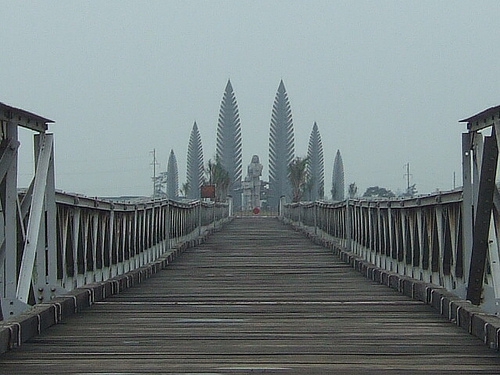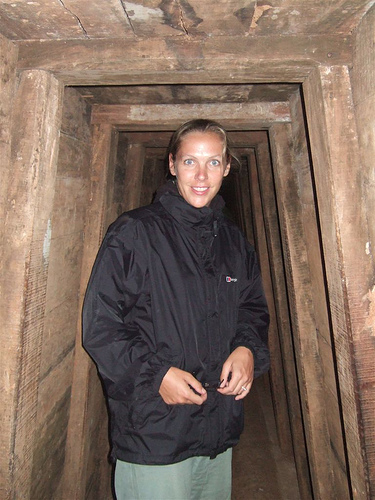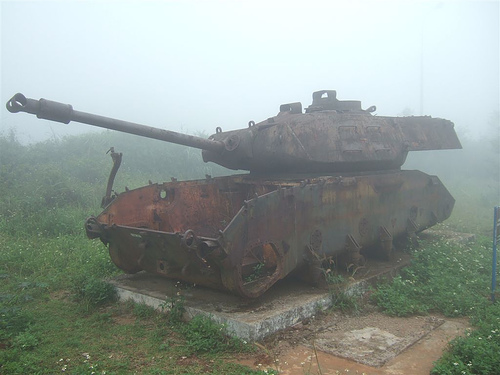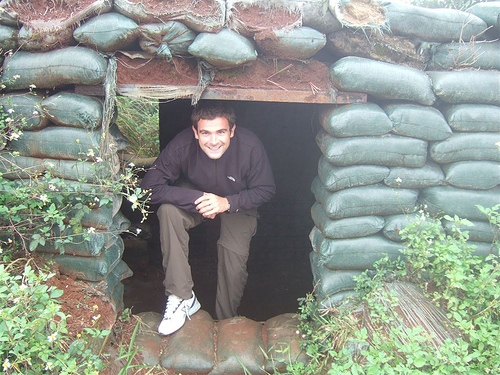Hue: ‘I love the smell of tiger balm in the morning’
20th March 2007
As the rain came down in Hoi An, we broke our vow to never get on another Vietnamese bus, and headed north to the former capital city Hue (pronounced like Howay, as in Howay the Lads).
Thankfully, Hue was only 4 hours drive from Hoi An (its amazing how travelling changes your perspective of journey times, a 4 hour bus trip now feels like your just popping out to the local shops!). The other good news about arriving in Hue, was that it is on the main North – South train line, as were the rest of our planned stops in Vietnam, so this really was the last bus trip we would have to endure!
Hue dosen’t have too much going for it. There is an old citadel (which we wandered around), some Pagodas (which we skipped) and the DMZ cafe, which sells first class chocolate mousse (which we sampled twice!). However, the main reason for our stop off in Hue was to pick up a trip to the surrounding countryside, the scene of the main fighting during the Vietnam War.
Hue is located just outside the former Demilitarised Zone, a 10km wide stretch of land that used to split Vietnam in two, passing from the coast to the border with Loas, either side of the Ben Hai River. The River used to form the demarcation line between North and South Vietnam, and the Demilitarised Zone was set up to prevent the armies of the two sides getting too close to each other. As tensions mounted and the Americans arrived, the Demilitarised Zone ironically became the most militarised place on the planet.
We chose to visit the Demilitarised Zone (DMZ – note to our allies from across the Atlantic, this is prononced DMZ, not DMZeeee, despite what you learned on Sesame Street) on a guided tour which left Hue at 6.30am. We headed first to the Ben Hai River, saw an old bridge (which used to be painted half red, and half yellow) with gaurd towers on either side. The original loud speakers are still on the towers which were used during the war to transmit propoganda messages.

From here we crossed into the former North Vietnam and headed to the Vinh Moc tunnels. There are 2.8kms of underground tunnels here, and unlike Chu Chi, which we visited previously, the tunnels have been left as they were, not altered for the tourists. Having nearly cried like a big girl in the tunnels at Chu Chi (Well done to Uncle Jack, who despite being a Charlton fan was brave enough to take on the entire Chu Chi tunnel experience!), I was ready to sit out the tunnel tour, but we were assured by our guide that these tunnels were much more spacious than Chu Chi, and thankfully he was right! The Vinh Moc tunnels were bigger than Chu Chi as they were used for living in, rather than fighting, and the impressive network included a hospital, (including a maternity wing where 20 children were born during the conflict), classrooms, etc etc.

After the tunnels we got back on our bus and headed out along Highway 1, past the former American base at Doc Mieu and countless war cemeteries with thousands of identical, aligned headstones, very sobering. After lunch we moved onto Highway 9, and further inland to visit ‘The Rockpile’, which used to be a strategic lookout for the Americans, but now has reverted to simply being a pile of rocks. We also saw the Dakrong Bridge which was a critical part of the Ho Chi Minh trail, used by the North to supply its fighters as they moved South.

Finally, we visited the ‘Khe Sanh Combat Base’ which was the scene for a famous siege in 1968 which cost the lives of 500 Americans and 10,000 North Vietnamese troops. There is very little of the base still in tact today, but as the mists rolled in from the surrounding hills, the area had a very, very eerie feeling about it. There was also a small museum here, with a comments book in which many Vietnam Veterans have recorded there thoughts about the conflict on their subsequent return, which made for very moving reading.

And that was just about it, we returned to Hue, from where the following night we would depart on the night train (how exciting!) to Hanoi. OK, so our trip to Hue and the DMZ will not feature in the hightlights of our year away, but we did get to learn some history of the war, which will stick in the mind much more having visited the battlefields.
Tags: Vietnam

Leave a Reply